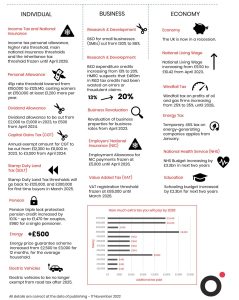Rural Client Update - Winter 2022
If you have any questions about any of the below please do get in touch with your Old Mill adviser in the first instance, or alternatively click here…

13th December 2022
-
Willem Puddy See profile
-
Making Tax Digital (MTD) for Income Tax Self-Assessment (ITSA)
From the 6 April 2026 self-employed businesses and landlords with income above £50,000 per annum, will need to follow the new rules for Making Tax Digital for Income Tax.
Those with income between £30,000 and £50,000 will be mandated from April 2027.
This has been extended twice now, once from the original April 2023 roll out and now from a roll out of April 2024. The start of MTD for Income Tax, will mean that all businesses will need to be on HMRC compatible software, which if you already are for VAT, you are also ready for Income Tax.
The new rules will mean that you will have to submit a quarterly Income Tax return from your HMRC compliant accounting software. These quarterly returns would be an estimate of your tax liability and do not need to include accounting or tax adjustments. Along with the quarterly submissions due one month after each quarter, you will still be required to submit a final declaration of your final income position.
The final income position would be your year-end accounts and personal tax return as you know it today. The same deadline of the 31 January following the tax year end will also still apply.
Partnership businesses, which were due to be mandated from April 2025 will now be rolled out at an, as yet unknown later date.
For more details on MTD take a look at our Frequently Asked Questions or speak to your usual Old Mill contact.
-
Making Tax Digital (MTD) for VAT
From the 1st of November 2022 you will not be able to use your existing VAT online account to send your monthly or quarterly returns.
You would have hopefully now managed to link your government gateway to your compliant HMRC software, which you will now have to use to submit your VAT return form. Please do get in touch with us if you require Old Mill to help you with ensuring that you are all set up.
For more details on MTD take a look at our Frequently Asked Questions or speak to your usual Old Mill contact.
-
Sole Trade and Partnership - Basis period reform
With effect from the 6 April 2024, all sole trades and partnerships that are subject to Income Tax will be taxed in relation to the tax year and not their accounting year end.This change in the legislation announced in the Finance Bill 2021-22 largely links up with the above MTD for ITSA and ensuring that for Income Tax purposes the government will receive estimates for all sole trade and partnership businesses throughout the tax year, largely giving them an estimated tax collection due by 31 January post the tax year end.If your accounting year end is not either the 31 March or 5 April you will have a transition year during the 2023/24 tax year where you will need to report your profits in two parts:
1. The normal 12-month period ending in the tax year. The normal accounting period you’re used to.
2. The remaining profits in the period to the 5 April 2024, the ‘transitional element’.If the above scenario is your business, it will mean that during the tax year ending 5 April 2023, you will be taxed on profits for a period longer than 12 months.The Finance Bill also provides for the profits in the transitional year (less overlap profits) to be spread across 5 years, to help spread the cash flow burden.The Bill also allows for the 5-year spread of the profits to be accelerated in a period if elected, allowing for additional profits from the transitional year to be allocated (if available) to lower taxable income years.It’s important to speak to your adviser to ensure that each aspect of the basis period reform has been considered and that overlap profits from the first year of trading are obtained and available to use ahead of the transitional year end. -
VAT and Income Tax Self-Assessment - Penalties reform
HMRC are rolling out a new penalty for late submission of VAT returns or Self-Assessment Tax Returns.
The reform will start on the 1 January 2023 for VAT and for Income Tax the start date will align with the MTD and basis period reform dates for Income Tax from the 6 April 2024.
The new regime will be based around a points-based system that will be in place for all regular submissions, this will therefore be in place for the submission obligations stated above for both MTD and VAT returns and a MTD Income Tax submission.
The points-based system will however not replace the old rules on occasional submissions, for example a one-off transaction like a Residential Property Return.
How the points system will work:
The taxpayer will receive a point for every late submission and HMRC will notify them of this point received.
There will be different thresholds for a £200 financial penalty based on the frequency of your submissions.
They are as follows:
Submission Frequency Penalty Threshold Annual 2 points Quarterly (Including MTD for ITSA) 4 points Monthly 5 points There will be separate points totals for each submission obligation. For example, if you submitted quarterly VAT returns and the MTD for ITSA as stated above. Therefore, if you have 3 late submissions for VAT returns and MTD for ITSA, your next late submission and every subsequent late submission would be charged the £200 penalty.
If you do not reach the penalty threshold your points will expire 2 years after the subsequent month of issue. Once you have reached the penalty threshold, the points total will only be reset to zero once a period of compliance has been reached.
This period of compliance differs per submission frequency:
Submission Frequency Penalty Threshold Annual 24 months Quarterly (Including MTD for ITSA) 12 months Monthly 6 months All historic submissions will need to be submitted as well as the period of compliance for the points total to be reset to zero.
-
Business Asset Disposal Relief (BADR)
BADR is the new name for Entrepreneurs’ Relief and has been in place since 6 April 2020.
If you qualify for BADR you will pay tax at 10% on all gains on qualifying assets up to a lifetime limit for each person of £1,000,000 compared to the previous £10,000,000 for Entrepreneurs’ Relief.
Any gains above the lifetime limit will be charged at the main rate of Capital Gains of 20% or 18% and 28% for residential property (FHLs).
The annual exemption allowance, this is the first amount of gain that is tax free is reducing from the current £12,300 in April 2023, to £6,000. Then a further reduction to £3,000 from April 2024.
It’s important that if you are thinking of ceasing to trade or the selling shares in your own company, that you speak with your adviser to ensure you have taken the necessary advice to reduce potentially large tax liabilities that can be mitigated with planning.
-
Capital Gains - Residential property
As at the time of writing the main rate of Capital Gains Tax on residential property is 28%.
There is also a requirement when there is a sale of residential property that’s not your main residence, for a ‘residential property form’ to be filed within 60 days and the tax liability to also be settled within 60 days of completion of the sale.
Again, at Old Mill we will be able to help you every step of the way and have a Capital Gains Tax Team to ensure you are meeting the necessary compliance on selling residential property.
Therefore, approaching any completion of a sale do let your relevant adviser know.
-
Inheritance Tax (IHT)
Agricultural Property Relief (APR) is available on farmed agricultural land held within an individual’s estate on death. This is a valuable relief that reduces the IHT due on the qualifying agricultural property.
We are constantly seeing increasing scrutiny over the relief, especially on the value of the farmhouse. Therefore, it is essential to get the necessary advice early to ensure that the necessary planning can be done.
With the government under increased fiscal pressure, stealth taxes on IHT could be a real possibility in the future for increasing the government’s tax collection. Ensure you speak with your adviser about IHT to ensure that everything is done as early as possible to maximise the advantage from forward planning.
The Chancellor announced that all nil rate bands were frozen until April 2028. There was no movement on Agricultural Property Relief or Business Property Relief (BPR), as valuable IHT reliefs and with the potential for reduction in the future, now is a good time to be planning for IHT liabilities.
For individual queries or a full IHT review speak to our Inheritance Tax Team.
-
Limited Company - Corporation Tax
The main rate of Corporation Tax will rise from the 1 April 2023 to 25% on profits in excess of £250,000.
Corporation Tax will stay at 19% on profits below £50,000, with a tapered rate of 26.5% for profits between £50,000 – £250,000.
-
Annual Investment Allowance (AIA)
AIA allows for 100% tax writing down allowance on qualifying plant and machinery purchases in the year of purchase. The current limit is currently set at £1,000,000 and was supposed to be reduced to £200,000 on the 1 April 2023 but has now been made permanent at £1,000,000.
This is one of the few areas of Kwasi Kwartng’s mini budget that has survived the subsequent abolishment of measures.
If you have a query, get in touch with your usual Old Mill adviser.
-
Limited Company - 130% Super Deduction
The 130% Super Deduction is currently only available to limited companies on purchases of brand-new plant and machinery, until the 31 March 2023. Assume that it will end on the planned date of 31 March 2023.
The Government confirmed there will be no movement on the Super Deduction and will be removed from the 1 April 2023 when the new Corporation Tax rates are introduced.
Feel free to check your status with us if you are thinking of purchasing new plant and equipment.
-
Limited Company - Dividends Tax
On the 6 April 2022 dividends were increased across the tax bands by 1.25% and the increase from the 6 April 2023 was going to be ring-fenced to form part of the NHS levy.
The NHS levy has now been scrapped but the increased 1.25% on all dividends is here to stay. Therefore, making the Dividend Tax rates as follows.
Tax year – 6 April 2022 to 5 April 2023:
The dividend allowance where 0% tax is due on the first £2,000 of dividends still applies until April 2023, when it will be reduced to £1,000 until April 2024 and then £500 until April 2024. The remaining dividends will be taxed in relation to the tax band they will fall into. Dividend income will go on top of your other income during the same tax year.
Tax Band Tax rate on dividend over the allowance Basic rate 8.75% Higher rate 33.75% Additional rate 39.35% -
Key changes from the Autumn statement
Personal Allowances, National Insurance and VAT thresholds are all frozen until April 2028. This will mean that more individuals will start to pay tax at a higher rates of Income Tax and more businesses will need to register for VAT. Therefore, it’s a good time, now we understand the outcome, to plan forward to minimise the effects of the frozen bands.
Energy:
Domestic usage will continue to get support from April 2023 with the price cap moving from £2,500 to £3,000 (based on average usage).
However, business usage was not mentioned in the statement apart from, a further statement will be made by the end of the year on the support that will be given. It’s likely that the support will be minimal therefore we will need to prepare for steep increases in the energy prices from April 2023.

-
Limited Company - Research and Development (R&D)
Despite what some people may think, you don’t actually need to be working in a lab to be undertaking Research and Development (R&D) – there doesn’t need to be potions or test tubes, and you definitely don’t need to be inventing space rockets!
Many farmers and those working in the wider agricultural industry don’t believe they can benefit from R&D tax relief, because ‘there can’t be much R&D happening in the rural space’. But this simply isn’t true. R&D tax relief applies to many sectors, and the agricultural sector is certainly one of them.
R&D tax credits are actually a government incentive. They are a way of rewarding and encouraging innovation, and statistics show they’re being drastically underclaimed. If eligible, you could receive total tax relief of 44p for each £1 spent, ultimately giving you more money to invest in your business.
There are a number of ways you can qualify for R&D relief; for example, you may have spent time developing a new product, process or service, or even enhancing an existing one. The project doesn’t even need to have succeeded in order for you to make a claim.
For more information contact our Research & Development Team.
Download copy here
If you have any questions about any of the above please do get in touch with your adviser in the first instance, or alternatively click here…

